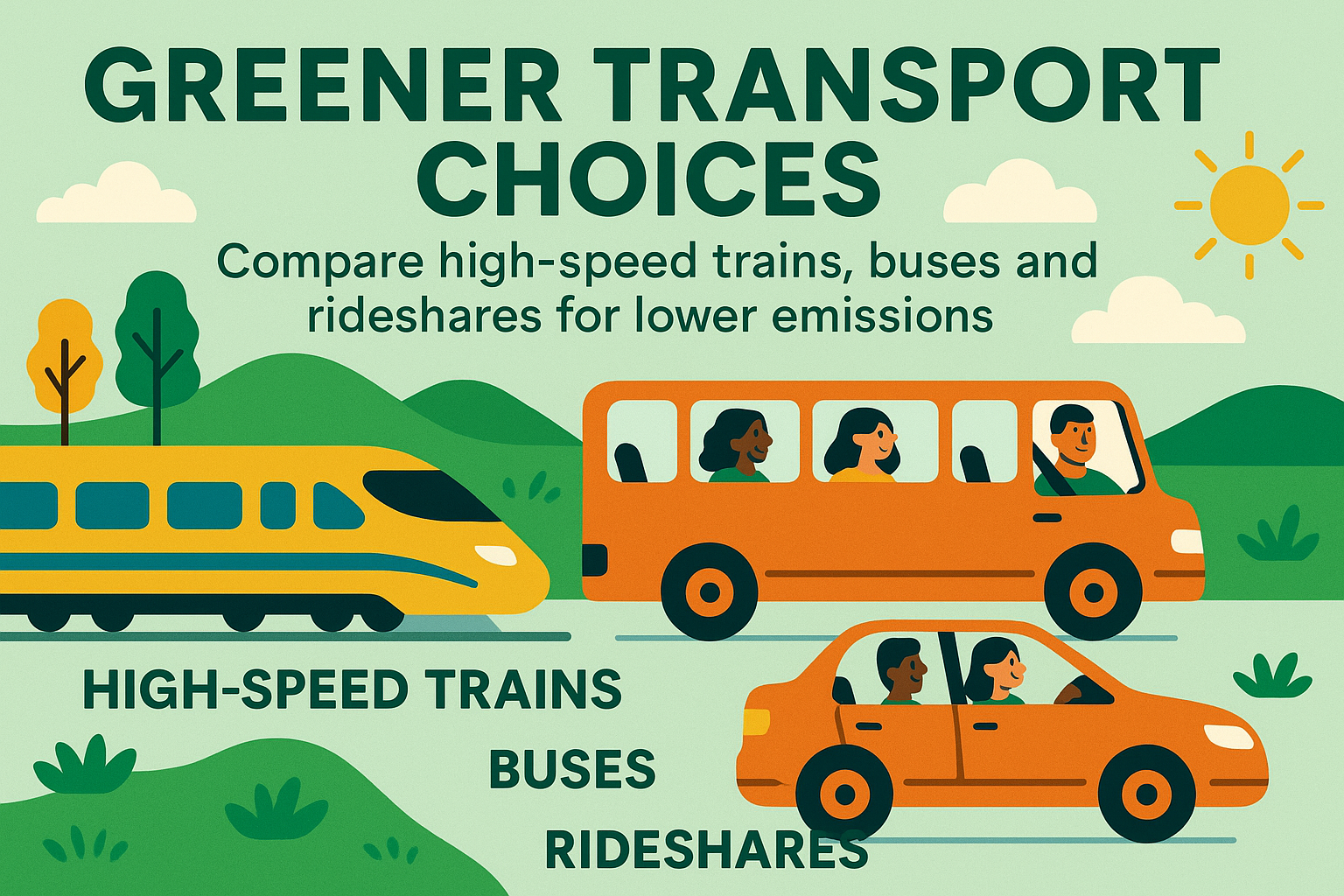Greener Transport Choices
As we strive to reduce our carbon footprint, the choices we make about how we travel play a crucial role. In this article, we’ll compare high-speed trains, buses, and rideshares as options for greener transport. Understanding the environmental impact of these modes of transport can help you make informed decisions while traveling.
Understanding Transport Emissions
Transportation is one of the largest contributors to greenhouse gas emissions. According to the Environmental Protection Agency (EPA), it accounts for nearly 29% of total greenhouse gas emissions in the United States. By choosing greener transport options, you can significantly reduce your own emissions. The key is to evaluate the environmental impact of each mode of transport.
High-Speed Trains: The Eco-Friendly Alternative
High-speed trains are increasingly recognized as one of the most sustainable forms of transport. They offer several advantages over traditional cars and planes:
- Lower Emissions: High-speed trains emit significantly less CO2 per passenger mile compared to planes and cars.
- Energy Efficiency: Trains are inherently more energy-efficient, particularly when powered by renewable energy sources.
- Reduced Congestion: By taking cars off the road, trains help ease traffic congestion, leading to less idling and emissions.
For example, in Europe, high-speed rail networks connect major cities efficiently, and countries like France and Japan have invested heavily in these systems, which have proven to be effective in reducing emissions. Additionally, trains often provide a more comfortable travel experience, allowing passengers to work or relax during their journey.
Case Study: European High-Speed Rail
The European high-speed rail network is a prime example of sustainable travel. In countries like France, Spain, and Germany, high-speed trains have become a preferred travel method for both short and long distances. This not only reduces emissions but also encourages a shift from air travel to rail travel, further contributing to environmental benefits.
Buses: The Unsung Heroes of Sustainable Travel
Buses often get overlooked when discussing sustainable transport options, yet they can be one of the most eco-friendly choices available:
- High Passenger Capacity: Buses can carry many passengers at once, leading to lower emissions per person compared to cars.
- Lower Fuel Consumption: Modern buses, especially those that use alternative fuels or electric engines, have a much lower carbon footprint.
- Accessibility: Buses often provide access to areas not serviced by trains, making them essential for comprehensive transport networks.
In cities like Los Angeles and New York, public bus systems are a vital part of the transport infrastructure, helping to reduce the number of private vehicles on the road. Moreover, many bus companies are adopting greener technologies, such as electric or hybrid buses, to further decrease their environmental impact.
Innovative Bus Programs
Some cities are implementing innovative bus programs that prioritize eco-friendliness and efficiency. For instance, the “electric bus rapid transit” systems in cities like Shenzhen, China, have transformed urban transport by providing a clean, efficient, and reliable option for commuters.
Ridesharing: Convenience Meets Sustainability
Rideshare services like Uber and Lyft have become popular for their convenience, but they also offer potential for reduced emissions:
- Pooling Options: Rideshare companies often provide carpooling options, which can lower the number of vehicles on the road.
- Flexible Transport: Ridesharing can fill gaps in public transport systems, ensuring that people have access to rides when they need them.
- Electric Fleet Initiatives: Many rideshare companies are transitioning to electric vehicles, which can significantly reduce emissions.
For instance, companies like Lyft are committing to 100% electric vehicles by 2030, demonstrating the potential for rideshares to become a greener option.
Challenges of Ridesharing
While ridesharing has its benefits, it’s important to acknowledge the challenges. The convenience can sometimes lead to increased traffic congestion, particularly in urban areas. Therefore, it’s essential to consider how ridesharing fits into the broader transportation ecosystem.
Comparing the Environmental Impact
When comparing high-speed trains, buses, and rideshares, it’s evident that each option has its unique advantages and limitations. Here’s a quick breakdown:
| Transport Mode | Average CO2 Emissions (g/km) | Passenger Capacity | Infrastructure Requirements |
|---|---|---|---|
| High-Speed Train | 29 | 300+ | Extensive rail network |
| Bus | 68 | 40-60 | Road infrastructure |
| Rideshare | 100+ | 1-4 | Minimal, but increases traffic |
High-speed trains emerge as the clear winner in terms of emissions per passenger mile, followed by buses. Rideshares, while convenient, tend to have higher emissions, particularly when not utilized in carpool mode.
12 Eco-Friendly Travel Tips
To make your travels more sustainable, consider these eco-friendly tips:
- Slow Travel: Take your time to enjoy your destination rather than rushing through multiple cities.
- Local Dining: Support local restaurants and eat seasonal, locally sourced food.
- Trains Over Flights: Opt for trains when possible, especially for short distances.
- Refill Bottles: Use a refillable water bottle to reduce plastic waste.
- Pack Light: The lighter your luggage, the less fuel needed for transport.
- Respect Wildlife: Observe wildlife from a distance and avoid disturbing their habitats.
- Offset Emissions: Invest in carbon offset programs to balance your travel emissions.
- Energy/Water Saving: Be mindful of energy and water consumption during your stay.
- Volunteer: Participate in local conservation efforts during your travels.
- Experiences Over Souvenirs: Choose experiences that enrich your travel rather than material souvenirs.
- Plastic-Free Kits: Carry a kit with reusable straws, utensils, and bags.
- Educate Others: Share your sustainable travel practices with fellow travelers.
Conclusion: Choose Wisely for a Greener Future
Ultimately, the choices we make about transport can have a profound impact on the environment. By opting for high-speed trains, buses, or rideshares, we can contribute to a more sustainable future. Consider your options carefully, and remember that every small change counts.
For more tips on sustainable travel, visit our Travel hub and explore how technology is shaping eco-friendly options in our Tech section.
Call to Action
Ready to make your next journey more sustainable? Start by planning your trip with one of these greener transport options today!
